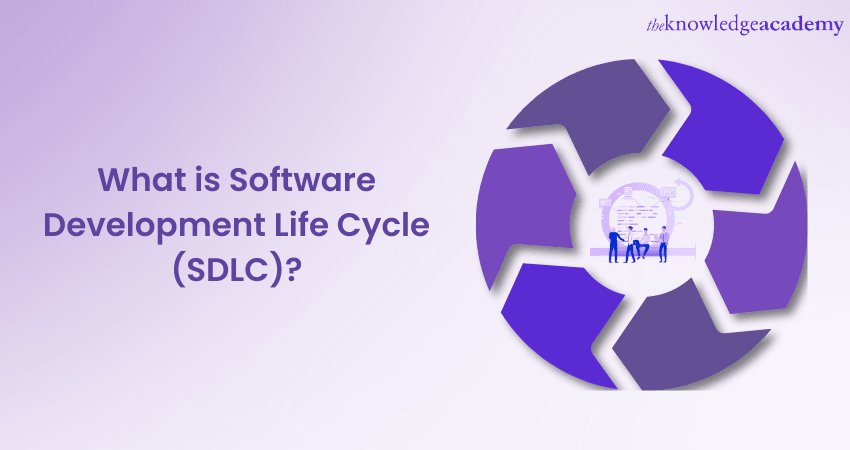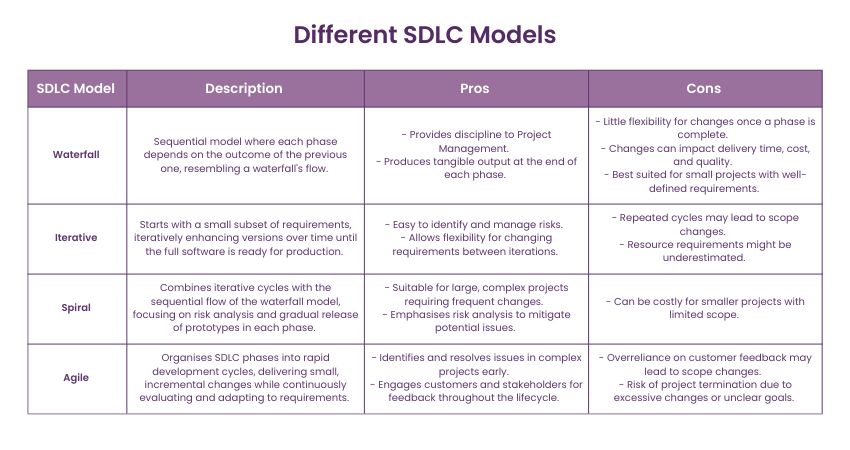We may not have the course you’re looking for. If you enquire or give us a call on +918037244591 and speak to our training experts, we may still be able to help with your training requirements.
We ensure quality, budget-alignment, and timely delivery by our expert instructors.

Behind every software application, be it a powerful data analytics tool or a simple mobile game, lies a meticulously crafted process that ensures its functionality, reliability, and efficiency. The Software Development Life Cycle (SDLC) is that process that functions as the blueprint for crafting exceptional software. Think of it as the ideal game plan, guiding teams through every step—from brainstorming and design to testing, deployment, and beyond. Understanding What is Software Development Life Cycle is vital for any Developer.
Essentially, it’s the secret to turning your best software ideas into reality while staying on track, on time, and within budget. This blog dissects What is Software Development Life Cycle, revealing its various [phases, models, benefits and more. So read on and learn what drives the heartbeat of any thriving software!
Table of Contents
1) What is Software Development Life Cycle (SDLC)?
2) How Does SDLC work?
3) Importance of Software Development Life Cycle
4) Software Development Life Cycle Models
5) How can DevSecOps be Integrated Into SDLC?
6) Benefits of Following an SDLC
7) Is SDLC Waterfall or Agile?
8) What is the Agile Model in SDLC?
9) What is SDLC in Scrum?
10) Conclusion
What is Software Development Life Cycle (SDLC)?
Here you are going to have a brief overview on SDLC. It is a structured framework used by Developers and teams to design, develop, test, and deploy high-quality software. It represents a systematic, sequential approach where software creation is broken down into different phases, ensuring that every stage from conception to post-deployment runs smoothly and predictably.
1) SDLC streamlines the process of converting user requirements into functional software.
2) It minimises errors and enhances overall efficiency in Software Development.
3) It ensures projects meet or exceed customer expectations, are delivered on time, and stay within budget.
4) It serves as a strategic guide for:
a) Clear stakeholder communication.
b) Effective Risk Management.
c) Continuous feedback integration.
5) Each phase of the SDLC is essential, with specific goals and deliverables defining its success.
How Does SDLC Work?
The Software Development Life Cycle defines the various tasks of creating a software application. It progresses through multiple stages as Developers introduce new features and address bugs. Although the specifics of the SDLC process can vary across teams, there are several common phases, which are detailed below:
Planning
a) The planning phase involves cost-benefit analysis, scheduling, resource estimation, and allocation.
b) Requirements are gathered from stakeholders such as Customers, Experts, and Managers.
c) A Software Requirement Specification (SRS) document is created to set expectations and define project goals.
d) The team estimates costs, creates a schedule, and formulates a detailed plan to achieve the goals.
Design
a) In the design phase, Software Engineers analyse requirements to determine the best solutions for creating the software.
b) They consider integrating pre-existing modules, making technology choices, and selecting software development tools.
c) The team evaluates how to seamlessly integrate the new software into the organisation’s existing IT infrastructure.
Implementation
a) In the implementation phase, the Development Team begins coding the software product.
b) The team carefully analyses the requirements to break them down into smaller, manageable coding tasks.
c) Developers focus on completing these smaller tasks daily to make consistent progress.
d) The aim is to align these tasks with the overall project goals and gradually achieve the final result.
Testing
a) In this phase, the Development Team uses a combination of automation and manual testing to identify and fix bugs.
b) Quality Analysis involves checking the software for errors and ensuring it meets customer requirements.
c) Testing often runs parallel to the development phase, with teams testing code immediately after writing it.
Deployment
a) Teams code and test software on a separate copy, distinct from the version users access.
b) The version used by customers is referred to as the production environment, while development and testing occur in the build or testing environment.
c) Separate build and production environments ensure customers can use the software uninterrupted during changes or upgrades.
d) The deployment phase involves tasks to move the latest build to the production environment, including packaging the software, configuring the environment and installing the updated version.

Maintenance
a) The maintenance phase involves fixing bugs and addressing customer-reported issues to ensure the software operates smoothly.
b) The team manages software changes, such as updates or modifications, to meet evolving requirements.
c) Continuous monitoring of system performance, security, and user experience helps identify potential improvements.
d) The team implements enhancements and optimisations to refine the existing software and maintain its reliability and efficiency.
Understand how to implement Change Management and Release Management plan with our Software Development Lifecycle Training – Register now
Importance of Software Development Life Cycle
The Software Development is the backbone of the software industry. It provides a structured framework for the creation, deployment, and maintenance of software applications. Its comprehension is pivotal for various reasons:
a) Predictability and Planning: By following the SDLC, organisations can anticipate project requirements, from resources to timelines. This predictability aids in meticulous planning and setting realistic expectations.
b) Quality Assurance: The SDLC emphasises rigorous testing and validation. By understanding and adhering to its stages, developers like you can ensure that the end product meets the desired quality standards. This also makes sure that it is free from critical issues.
c) Cost Efficiency: An intimate knowledge of the SDLC helps in the early detection of potential problems, thus reducing the cost of rectifications later. Avoiding last-minute changes or fixes can result in significant cost savings.
d) Stakeholder Communication: Understanding the SDLC facilitates better communication with stakeholders. They gain clarity on project progress, expectations, and potential bottlenecks, leading to more productive collaboration.
e) Continuous Improvement: The SDLC isn't static. With a deep understanding of its intricacies, teams can refine and adapt the process, optimising it for evolving technologies and methodologies.
f) User-centric Development: The SDLC mandates user involvement, especially in requirement gathering and acceptance testing. This ensures that the software aligns with your needs and expectations. This helps in fostering a user-centric development approach.
Unlock the secrets of top-tier Software Engineering by signing up for our Software Engineering Training.
Software Development Life Cycle Models
The Software Development encompasses various models. Each of these models are tailored to different project needs and organisational workflows. The following table will help you to understand these models:

Transform your Software Development approach with our Agile Software Development Training – Sign up now!
How can DevSecOps be Integrated Into SDLC?
DevSecOps can be integrated into SDLC by following some best practices. Here are the steps you can take to achieve this integration:
1) Planning and Requirement Analysis: This involves identifying security requirements, potential threats, and best practices for mitigation.
2) Architectural Design: In this step you must use security principles to address risks through Threat Modelling, access control, encryption, and Risk Analysis.
3) Software Development and Testing: You can conduct code reviews and perform vulnerability tests (such as penetration testing) to ensure security.
4) Deployment: In this step, you use automated DevSecOps tools and configure firewalls, access controls, and security settings for secure deployment.
5) Maintenance: Last but not the least, continuously monitor for vulnerabilities and apply security updates as needed.

Benefits of the SDLC
The SDLC brings several benefits to Developers that help streamline and improve the Software Development process. Here are some key benefits:
1) Improves Product Quality: By breaking down the development process into distinct phases, SDLC promotes early detection of defects and issues. This ensures high-quality software products.
2) Improves Project Management: SDLC provides a structured approach with clear milestones and deliverables. This makes it easier to manage projects, track their progress, and ensure the project stays on schedule and within budget.
3) Risk Mitigation: SDLC's iterative nature allows for continuous risk assessment and mitigation. It reduces the likelihood of project failure significantly.
4) Efficient Resource Utilisation: By allocating resources effectively, SDLC helps optimise available resources, reduce waste, and improve efficiency.
5) Increases Visibility and Control: Each phase of the SDLC has specific deliverables. It allows stakeholders to monitor progress and make informed decisions throughout development.
6) Flexibility and Adaptability: Depending on the chosen SDLC model, teams can adapt more effectively to changing market conditions and evolving customer needs.
Master the art of Software Design and architecture with our Software Design and Architecture Training - Sign up now!
Is SDLC Waterfall or Agile?
The SDLC can cover both Waterfall and Agile methodologies. Waterfall is a linear, sequential approach, and Agile is an iterative and incremental approach. The choice between the two depends on the project's requirements.
What is the Agile Model in SDLC?
The Agile model in SDLC breaks projects into smaller, manageable units called iterations or sprints. These sprints typically last a few weeks, allowing teams to swiftly adapt to changes and deliver functional software incrementally.
What is SDLC in Scrum?
Scrum is an Agile framework. In that context, the SDLC is often adapted to emphasise iterative development, collaboration, and flexibility. It includes various phases such as planning, design, and development, but these are executed in shorter cycles or sprints to help with frequent reassessment.
Conclusion
Discover the different paths in a Software Development Career today!
SDLC is a foundational framework in Software Engineering. Understanding What is Software Development Life Cycle helps in guiding teams from conceptualisation to deployment and maintenance in a seamless manner. Understanding its various models, from the structured Waterfall to the adaptive Agile, equips professionals with the right skills to navigate the complexities of software creation.
Master the skills to create modular programs and reusable codes with Java in our Java Programming and Software Engineering Fundamentals Training - Sign up now!
Frequently Asked Questions
How to use SDLC in a Project?

To use the SDLC in a project, you typically follow these phases:
a) Planning
b) Analysis
c) Design
d) Implementation
e) Testing
f) Deployment
g) Maintenance
What is Jira in SDLC?

Jira is a widely used Project Management tool for the Software Development Life Cycle. It helps teams plan, track, and manage their software projects. Here are some key ways Jira supports the SDLC:
a) Task Management
b) Bug tracking
c) Collaboration
d) Reporting and Analytics
What are the Other Resources and Offers Provided by The Knowledge Academy?

The Knowledge Academy takes global learning to new heights, offering over 3,000 online courses across 490+ locations in 190+ countries. This expansive reach ensures accessibility and convenience for learners worldwide.
Alongside our diverse Online Course Catalogue, encompassing 19 major categories, we go the extra mile by providing a plethora of free educational Online Resources like News updates, Blogs, videos, webinars, and interview questions. Tailoring learning experiences further, professionals can maximise value with customisable Course Bundles of TKA.
What is The Knowledge Pass, and How Does it Work?

The Knowledge Academy’s Knowledge Pass, a prepaid voucher, adds another layer of flexibility, allowing course bookings over a 12-month period. Join us on a journey where education knows no bounds.
What are the Related Courses and Blogs Provided by The Knowledge Academy?

The Knowledge Academy offers various Software Engineering Courses, including the Systems Modelling Techniques Course and the Agile Software Development Training. These courses cater to different skill levels, providing comprehensive insights into How to Become a Software Architect.
Our Programming & DevOps Blogs cover a range of topics related to Software Development, offering valuable resources, best practices, and industry insights. Whether you are a beginner or looking to advance your Software Engineering skills, The Knowledge Academy's diverse courses and informative blogs have got you covered.






 Top Rated Course
Top Rated Course




 If you wish to make any changes to your course, please
If you wish to make any changes to your course, please


